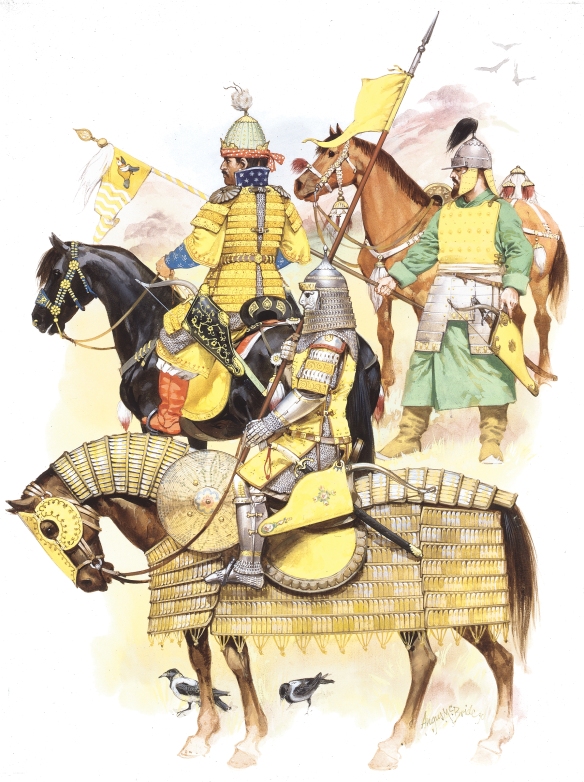In 1401 the great Islamic historian Ibn Khaldun (1332–1406) was in the city of Damascus, then under siege by the mighty Tamerlane. Eager to meet the famous conqueror of the day, he was lowered from the walls in a basket and received in Tamerlane’s camp. There he had a series of conversations with a ruler he described (in his autobiography) as ‘one of the greatest and mightiest of kings . . . addicted to debate and argument about what he knows and does not know’. Ibn Khaldun may have seen in Tamerlane the saviour of the Arab–Muslim civilization for whose survival he feared. But four years later Tamerlane died on the road to China, whose conquest he had planned.
Tamerlane (sometimes Timur, or Timurlenk, ‘Timur the Lame’ – hence his European name) was a phenomenon who became a legend. He was born, probably in the 1330s, into a lesser clan of the Turkic-Mongol tribal confederation the Chagatai, one of the four great divisions into which the Mongol empire of Genghis (Chinggis) Khan had been split up at his death, in 1227. By 1370 he had made himself master of the Chagatai. Between 1380 and 1390 he embarked upon the conquest of Iran, Mesopotamia (modern Iraq), Armenia and Georgia. In 1390 he invaded the Russian lands, returning a few years later to wreck the capital of the Golden Horde, the Mongol regime in modern South Russia. In 1398 he led a vast plundering raid into North India, crushing its Muslim rulers and demolishing Delhi. Then in 1400 he returned to the Middle East to capture Aleppo and Damascus (Ibn Khaldun escaped its massacre), before defeating and capturing the Ottoman sultan Bayazet at the Battle of Ankara in 1402. It was only after that that he turned east on his final and abortive campaign.
Despite his reputation as a bloodthirsty tyrant, and the undoubted savagery of his predatory conquests, Tamerlane was a transitional figure in Eurasian history. His conquests were an echo of the great Mongol empire forged by Genghis Khan and his sons. That empire had extended from modern Iran to China, and as far north as Moscow. It had encouraged a remarkable movement of people, trade and ideas around the waist of Eurasia, along the great grassy corridor of steppe, and Mongol rule may have served as the catalyst for commercial and intellectual change in an age of general economic expansion. The Mongols even permitted the visits of West European emissaries hoping to build an anti-Muslim alliance and win Christian converts. But by the early fourteenth century the effort to preserve a grand imperial confederation had all but collapsed. The internecine wars between the ‘Ilkhanate’ rulers in Iran, the Golden Horde and the Chagatai, and the fall of the Yuan in China (by 1368), marked the end of the Mongol experiment in Eurasian empire.
Tamerlane’s conquests were partly an effort to retrieve this lost empire. But his methods were different. Much of his warfare seemed mainly designed to wreck any rivals for control of the great trunk road of Eurasian commerce, on whose profits his empire was built. Also, his power was pivoted more on command of the ‘sown’ than on mastery of the steppe: his armies were made up not just of mounted bowmen (the classic Mongol formula), but of infantry, artillery, heavy cavalry and even an elephant corps. His system of rule was a form of absolutism, in which the loyalty of his tribal followers was balanced against the devotion of his urban and agrarian subjects. Tamerlane claimed also to be the ‘Shadow of God’ (among his many titles), wreaking vengeance upon the betrayers and backsliders of the Islamic faith. Into his chosen imperial capital at Samarkand, close to his birthplace, he poured the booty of his conquests, and there he fashioned the architectural monuments that proclaimed the splendour of his reign. The ‘Timurid’ model was to have a lasting influence upon the idea of empire across the whole breadth of Middle Eurasia.
But, despite his ferocity, his military genius and his shrewd adaptation of tribal politics to his imperial purpose, Tamerlane’s system fell apart at his death. As he himself may have grasped intuitively, it was no longer possible to rule the sown from the steppe and build a Eurasian empire on the old foundations of Mongol military power. The Ottomans, the Mamluk state in Egypt and Syria, the Muslim sultanate in northern India, and above all China were too resilient to be swept away by his lightning campaigns. Indeed Tamerlane’s death marked in several ways the end of a long phase in global history. His empire was the last real attempt to challenge the partition of Eurasia between the states of the Far West, Islamic Middle Eurasia and Confucian East Asia. Secondly, his political experiments and ultimate failure revealed that power had begun to shift back decisively from the nomad empires to the settled states. Thirdly, the collateral damage that Tamerlane inflicted on Middle Eurasia, and the disproportionate influence that tribal societies continued to wield there, helped (if only gradually) to tilt the Old World’s balance in favour of the Far East and Far West, at the expense of the centre. Lastly, his passing coincided with the first signs of a change in the existing pattern of long-distance trade, the East–West route that he had fought to control. Within a few decades of his death, the idea of a world empire ruled from Samarkand had become fantastic. The discovery of the sea as a global commons offering maritime access to every part of the world transformed the economics and geopolitics of empire. It was to take three centuries before that new world order became plainly visible. But after Tamerlane no world-conqueror arose to dominate Eurasia, and Tamerlane’s Eurasia no longer encompassed almost all the known world.
